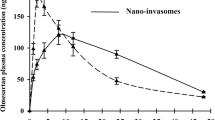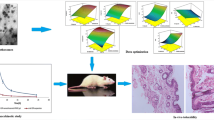Abstract
Transdermal drug delivery methods prove markedly superior to oral or hypodermic alternatives. By circumventing first-pass medication metabolism and gastrointestinal breakdown, these methods afford patients increased convenience through a minimally invasive and painless process. A cutting-edge transdermal drug delivery device has emerged, combining nanoparticles with dissolving microneedles. This innovative technique seeks to elevate the transdermal administration of losartan potassium and hydrochlorothiazide (HCTZ). The optimized formulation demonstrated excellent results with 100 needles measuring 575 μm in length and a pointed end. FTIR confirmed ingredient compatibility, while PXRD indicated the amorphous nature of the drug, suggesting improved bioavailability. DSC and TGA verified the thermal stability of both formulations. Release studies exhibited a rapid release behavior from MNP-6, with 82.11% of losartan and 81.50% HCTZ released within 30 min, following a zero-order kinetics pattern confirming a controlled drug delivery system. Histopathological findings supported the biocompatibility of the developed formulations, indicating its potential as a transdermal delivery system for losartan and HCTZ. This drug-loaded nanoparticle-based microneedle patch holds promise for achieving improved bioavailability and a prompt response to elevated blood pressure, leading to effective hypertension management.












Similar content being viewed by others
Data Availability
No datasets were generated or analyzed during the current study.
References
Tanwar, H., & Sachdeva, R. (2016). Transdermal drug delivery system: A review. International Journal of Pharmaceutical Sciences and Research, 7(6), 2274.
Cheng, T., et al. (2023). Advance and challenges in the treatment of skin diseases with the transdermal drug delivery system. Pharmaceutics, 15(8), 2165.
Nazary Abrbekoh, F., et al. (2022). Application of microneedle patches for drug delivery; doorstep to novel therapies. Journal of Tissue Engineering, 13, 20417314221085390.
Bhadale, R. S., & Londhe, V. Y. (2023). Paliperidone palmitate-loaded zein-maltodextrin nanocomplex: Fabrication, characterization, and in vitro release. Journal of Pharmaceutical Innovation, 18(3), 1253–1263.
Tariq, N., Ashraf, M. W., & Tayyaba, S. (2022). A review on solid microneedles for biomedical applications. Journal of Pharmaceutical Innovation, 17(4), 1464–1483.
Bhadale, R. S., & Londhe, V. Y. (2023). Solid microneedle assisted transepidermal delivery of iloperidone loaded film: Characterization and skin deposition studies. Journal of Drug Delivery Science and Technology, 79, 104028.
Khalid, A., et al. (2023). Formulation and characterization of thiolated chitosan/polyvinyl acetate based microneedle patch for transdermal delivery of dydrogesterone. Saudi Pharmaceutical Journal, 31(5), 669–677.
Sartawi, Z., Blackshields, C., & Faisal, W. (2022). Dissolving microneedles: Applications and growing therapeutic potential. Journal of Controlled Release, 348, 186–205.
Ahmad, Z., et al. (2023). Fast dissolving microneedle patch for pronounced systemic delivery of an antihyperlipidemic drug. Pharmaceutical Development and Technology, 28(9), 896–906.
Liang, L., et al. (2020). Optimization of dip-coating methods for the fabrication of coated microneedles for drug delivery. Journal of Drug Delivery Science and Technology, 55, 101464.
Du, G., et al. (2017). Intradermal vaccination with hollow microneedles: A comparative study of various protein antigen and adjuvant encapsulated nanoparticles. Journal of Controlled Release, 266, 109–118.
Dzau, V. J., & Balatbat, C. A. (2019). Future of hypertension: The need for transformation. Hypertension, 74(3), 450–457.
Oh, G. C., & Cho, H. J. (2020). Blood pressure and heart failure. Clinical Hypertension, 26, 1–8.
Vidal-Petiot, E., et al. (2016). Cardiovascular event rates and mortality according to achieved systolic and diastolic blood pressure in patients with stable coronary artery disease: An international cohort study. The Lancet, 388(10056), 2142–2152.
Omboni, S., & Volpe, M. (2018). Management of arterial hypertension with angiotensin receptor blockers: Current evidence and the role of olmesartan. Cardiovascular Therapeutics, 36(6), e12471.
Nguyen, H. Q., et al. (2017). Prediction of losartan-active carboxylic acid metabolite exposure following losartan administration using static and physiologically based pharmacokinetic models. Journal of Pharmaceutical Sciences, 106(9), 2758–2770.
Ali, M., et al. (2022). Dissolvable polymer microneedles for drug delivery and diagnostics. Journal of Controlled Release, 347, 561–589.
Bhadale, R. S., & Londhe, V. Y. (2022). Inclusion complexed iloperidone loaded dissolving microneedles: Characterization, in-vitro study, and dermatopharmacokinetics. Journal of Drug Delivery Science and Technology, 68, 103063.
Singh, P., et al. (2019). Polymeric microneedles for controlled transdermal drug delivery. Journal of Controlled Release, 315, 97–113.
Ahmed, I., et al. (2024). Development of tamarind gum/β-CD-co-poly (MAA) hydrogels for pH-driven controlled delivery of capecitabine. Polymer Bulletin, 81(7), 6173–6205.
Arshad, S. (2024). Development and characterization of stimuli responsive quince gum/β-CD grafted poly (methacrylate) hydrogels for controlled delivery of acyclovir. Polymer Bulletin.
Li, Y., et al. (2019). Biodegradable therapeutic microneedle patch for rapid antihypertensive treatment. ACS Applied Materials & Interfaces, 11(34), 30575–30584.
Gera, A. K., & Burra, R. K. (2022). The rise of polymeric microneedles: Recent developments, advances, challenges, and applications with regard to Transdermal drug delivery. Journal of Functional Biomaterials, 13(2), 81.
Zulcaif, et al. (2022). Simvastatin loaded dissolvable microneedle patches with improved pharmacokinetic performance. Micromachines, 13(8), 1304.
Talegaonkar, S., & Bhattacharyya, A. (2019). Potential of lipid nanoparticles (SLNs and NLCs) in enhancing oral bioavailability of drugs with poor intestinal permeability. An Official Journal of the American Association of Pharmaceutical Scientists, 20, 1–15.
Hidayat Chai, M. H. (2018). Characterization and colloidal stability of surface modified zinc oxide nanoparticle. in Journal of Physics: Conference Series. IOP Publishing.
Zulcaif, et al. (2022). Toxicological evaluation of natural and synthetic polymer based dissolvable microneedle patches having variable release profiles. Cellulose Chemistry and Technology, 56, 777–786.
Perera, W. P. T. D., et al. (2022). Albumin grafted coaxial electrosparyed polycaprolactone-zinc oxide nanoparticle for sustained release and activity enhanced antibacterial drug delivery. RSC Advances, 12(3), 1718–1727.
Alwan, R. M., et al. (2015). Synthesis of zinc oxide nanoparticles via sol–gel route and their characterization. Nanoscience and Nanotechnology, 5(1), 1–6.
Du, H., et al. (2019). Hyaluronic acid-based dissolving microneedle patch loaded with methotrexate for improved treatment of psoriasis. ACS Applied Materials & Interfaces, 11(46), 43588–43598.
Wang, X., et al. (2020). Roles of pH, cation valence, and ionic strength in the stability and aggregation behavior of zinc oxide nanoparticles. Journal of Environmental Management, 267, 110656.
Singh, J., Kaur, G., & Rawat, M. (2016). A brief review on synthesis and characterization of copper oxide nanoparticles and its applications. Journal of Bioelectronics and Nanotechnology, 1(1), 9.
Ahmad, Z., et al. (2020). Fabrication and characterization of thiolated chitosan microneedle patch for transdermal delivery of tacrolimus. Aaps Pharmscitech, 21, 1–12.
Moharram, A., et al. (2014). Direct precipitation and characterization of ZnO nanoparticles. Journal of Nanomaterials, 2014, 20–20.
Abu-Much, A., et al. (2022). Preparation and characterization of flexible furosemide-loaded biodegradable microneedles for intradermal drug delivery. Biomaterials Science, 10(22), 6486–6499.
Nandini, N. (2021). Co-amorphous based supersaturated urea-Losartan potassium transdermal formulation for hypertension. International Journal of Pharmaceutical Research, 13(1), 09752366.
Li, W., et al. (2019). Rapidly separable microneedle patch for the sustained release of a contraceptive. Nature Biomedical Engineering, 3(3), 220–229.
Hirobe, S., et al. (2013). Development and clinical study of a self-dissolving microneedle patch for transcutaneous immunization device. Pharmaceutical Research, 30, 2664–2674.
Almazan, E. A., et al. (2020). Design and evaluation of losartan transdermal patch by using solid microneedles as a physical permeation enhancer. Iranian Journal of Pharmaceutical Research: IJPR, 19(1), 138.
Amer, M. A., et al. (2019). Development and evaluation of liquid oral controlled release systems for Losartan potassium. Journal of Applied Pharmaceutical Science, 9(8), 086–093.
Sirisha, P. L., Babu, G. K., & Babu, P. S. (2014). Conceptuation, formulation and evaluation of sustained release floating tablets of captopril compression coated with gastric dispersible hydrochlorothiazide using 23 factorial design. International Journal of Pharmaceutical Investigation, 4(2), 77.
Jahanbekam, S. (2023). Ultrasound-responsive hyaluronic acid hydrogel of hydrocortisone to treat osteoarthritis. International Journal of Biological Macromolecules, 240, 124449.
Akhtar, F. (2022). Impact of various monomers on release of losartan potassium from guar gum based polymeric network. Pakistan Journal of Pharmaceutical Sciences, 35(5), 307–1319.
Gioumouxouzis, C. I., et al. (2017). 3D printed oral solid dosage forms containing hydrochlorothiazide for controlled drug delivery. Journal of Drug Delivery Science and Technology, 40, 164–171.
Heer, A. S. (n.d.) Spectral characterization and anti-fungal activity (2017). of zinc oxide (ZNO) nanoparticles synthesized using cynodon dactylon leaf extract . World Journal of Pharmaceutical Research, 6(16), 587–1596.
Saini, A., et al. (2016). New conformational polymorph of hydrochlorothiazide with improved solubility. Pharmaceutical Development and Technology, 21(5), 611–618.
Latha, K., et al. (2011). Development of an optimised losartan potassium press-coated tablets for chronotherapeutic drug delivery. Tropical Journal of Pharmaceutical Research, 10(5), 551–558.
Funding
This research work was self-funded.
Author information
Authors and Affiliations
Contributions
R.I. wrote the main manuscript and M.I.K., S.J.U., and H.S.S. prepared figures. Z.A. and M.F.S reviewed the manuscript.
Corresponding authors
Ethics declarations
Ethical Approval
The study was conducted in accordance with the ethical guidelines established by the Animal Ethical Committee of Riphah Institute of Pharmaceutical Sciences, Riphah International University, Lahore campus (Protocol number: 49/PEC dated 4-1-2023).
Conflict of Interest
The authors declare no competing interests.
Research Involving Humans and Animals Statement
Please refer to "Declarations"
Informed Consent
Please refer to "Declarations"
Additional information
Publisher’s Note
Springer Nature remains neutral with regard to jurisdictional claims in published maps and institutional affiliations.
Rights and permissions
Springer Nature or its licensor (e.g. a society or other partner) holds exclusive rights to this article under a publishing agreement with the author(s) or other rightsholder(s); author self-archiving of the accepted manuscript version of this article is solely governed by the terms of such publishing agreement and applicable law.
About this article
Cite this article
Ijaz, R., Ahmad, Z., Khan, M.I. et al. Revolutionizing Hypertension Management: Cutting-Edge Microneedle Patch Infused with Zinc Oxide Nanoparticles for Advanced Transdermal Drug Delivery. BioNanoSci. (2024). https://doi.org/10.1007/s12668-024-01428-7
Accepted:
Published:
DOI: https://doi.org/10.1007/s12668-024-01428-7




